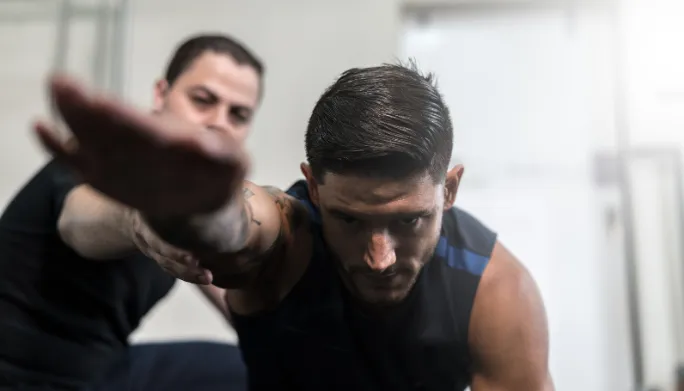Speed is a greatly desired thing that most golfers want more of – though I have found that many may not readily admit it. For some it’s hard to admit they’ve lost distance over the years (I’ll tell you later on in this article how to GAIN this back – and quickly). There is no way around the data on the PGA Tour – the players that win the most money also hit the ball the farthest. When it comes to your average golfer, from what I’ve seen with the hundreds I’ve worked with, most are below average for swing speed with their age range (meaning 30-39, 40-49, 50-59, 60-69, 70-79 and so on, with the data separated male/female as well). So what does this mean for you? How can you add speed to your swing without getting hurt? I’ll tell you the short answer: you need to be able to move well, without pain, have enough mobility, have enough strength and power to match your swing speed, and be efficient with how you use the ground. Now let’s go more in depth with this below.
Why is it so common to lose distance as we get older? Well, a simple answer is we get tighter and it gets harder to move. For many, it’s back pain and the problem of swinging too hard and the fear of getting hurt. For others it’s the desire of feeling in control with the club and making sure good contact is made and to avoid over-swinging. A big piece of the puzzle is how you move, so let’s go over what you absolutely need to have for flexibility before you can add more speed.
Mobility And Flexibility – The 4 Rotational Centers Of The Golf Swing
We have 4 rotational centers of the golf swing – the neck, shoulder, spine and hips. How well you move in all 4 of these rotational centers will be a big factor in how well you’re able to create speed in your swing.
Neck Rotation
How well can you turn / rotate your neck? Are you able to turn your head 70 degrees each direction? If you’re unable to turn your head 70 degrees each direction then we’re dealing with something that needs to be addressed before we ever think about adding speed to the swing.

The big thing with this test is that we want to keep our mouth closed and we want to make sure that when we turn we don’t shrug our shoulders or tilt our neck while we test the neck rotation. Out of all of the rotational tests this one should be the easiest to pass. If you’re not passing this test then THIS is where we need to start. Having a limitation with being able to turn your neck can lead to other injuries because of compensations you may make in your golf swing – likewise, it may lead to swing faults that you’re wanting to avoid (like early extension). If you have limited neck mobility and flexibility – take advantage of a free 30 minute golf evaluation to help develop a clear routine to fix this mobility problem.
Shoulder Rotation
Next, we need to have enough shoulder mobility for the golf swing. Why is shoulder mobility important? Without it, it would be very difficult to be consistent with your swing plane and it may
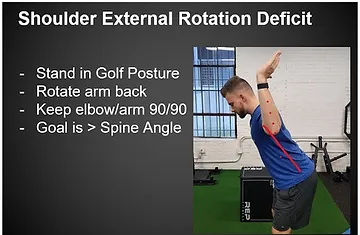
lead to things like casting or coming over the top with your swing.
For this test, we want to set up in a 5 or 6 iron posture and the goal here is to be able to rotate our lower arm past “spine angle”.
Spine angle is demonstrated in the picture as the solid red line and the shoulder “rotation” is demonstrated by where the forearm is in relation to that solid red line. For this test we lift up our arms to 90 degrees where the upper arm is parallel to the floor and we rotate our lower arm while making sure we don’t arch from the lower back.
Not having enough shoulder rotation will be a big reason why you may not be able to add speed to your swing. It is also why you might be dealing with inconsistency in your contact with the ball.
If you have difficulty with this test, or lack shoulder mobility and flexibility – again, I would encourage you to schedule a free 30 minute golf evaluation to talk about how this can be improved.
Spine Rotation

Next up we have our spine rotation test – also known as the “shoulder turn” or “feeling tight in my torso” in the backswing or downswing. The key here with this test is to make sure that we isolate the spine from the pelvis.
To do this, place a foam roller (or pillow) between the legs and slightly squeeze it as you rotate and see if you’re able to turn at least 55 degrees each direction. This is one of the more common rotational tests to fail and a lot of people experience cramping with this test as well. If you have trouble turning in your backswing or in your downswing this is likely a big contributor to that problem. It would be very hard to create speed without being able to rotate through our spine effectively without tightness.
If you have difficulty with turning in your swing and lack turn flexibility, I would encourage you to schedule a free 30 minute golf evaluation so that this area can be improved (and not lead to an injury in the future).
Hip Internal Rotation
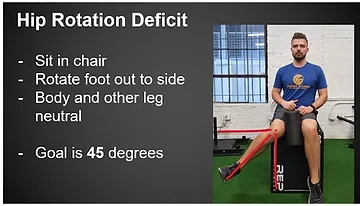
Lastly, we have the hips. Are you able to turn your hips at least 45゚with this hip internal rotation test as depicted in this picture. The hips are a big reason why golfers will experience low back pain. The number one predictor of lower back pain in golfers is having limited hip rotation and lack of flexibility in the hips.
If this is you, this is a big deal for longevity as a golfer. This is often the most commonly failed test that golfers will fail. If you’re over the age of 40 and male then you will likely fail this test. This is also the most commonly reported area of tightness in male golfers. For this test we want to make sure that we don’t cheat by lifting up the hips or by bending from our spine as we test each side. Lack of flexibility in the hips will also potentially lead to swing changes that can cause neck pain, shoulder pain and back pain. If you failed this test then I highly recommend taking full advantage of our free 30 minute golf evaluation – this is not an area you want to miss out on improving – if you do that, it’s almost guaranteeing you will have difficulty as a golfer and never reach your speed potential without injury.
Most golfers will fail 2 out of 4 of these tests. 75% of the golfers over the age of 50 will fail at least 2 of these tests. If you’re failing in any of these areas then this is the first place that you need to focus on. Everything else will likely be futile if you don’t clear up the mobility and flexibility side of the coin.
The Strength And Power Continuum For Golfers
Your strength and power need to be up to par with how fast you’re swinging. If you swing too fast for what your body is able to handle, your body will likely break down (i.e. an injury). If you build your body’s capacity and the engine’s strength (the muscles/ tendons / joints) you will have a much better chance at creating higher speeds without getting injured. For example, based on some of our power tests and data when it comes to the strength and power continuum for golfers, if you wanna swing 105 mph, and you’re a male golfer over 50, you will need to be able to jump 16 inches and be able to throw a 6 pounds medicine ball 16 feet from a seated position without any momentum to have the appropriate “engine” for creating those speeds.
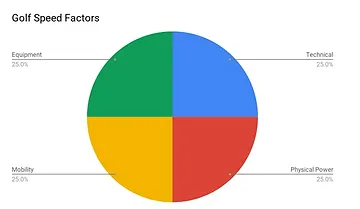
Strength training and flexibility/mobility routines specific for you will help create more speed and more consistency in your swing.
Physical power and mobility together make up 50% of the golf speed factors needed for more clubhead speed. The other 2 factors are equipment and technique – and all of these can be discussed in greater depth in the future if there is interest for it.
Here are 3 case studies of golfers I worked with a few years ago – their results are pretty common though not “average”. Through working on the physical strength, power, and mobility that they specifically needed, they gained A LOT of speed.
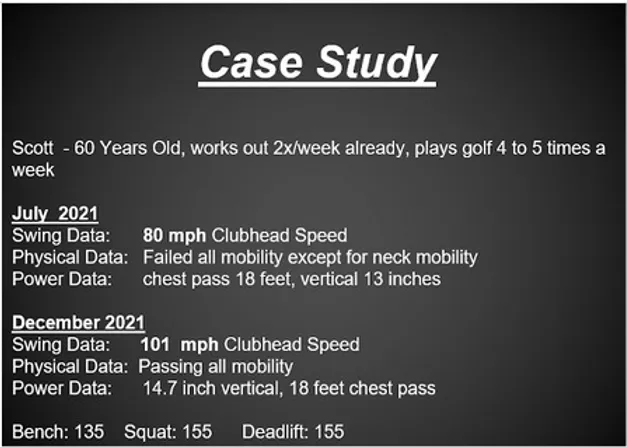

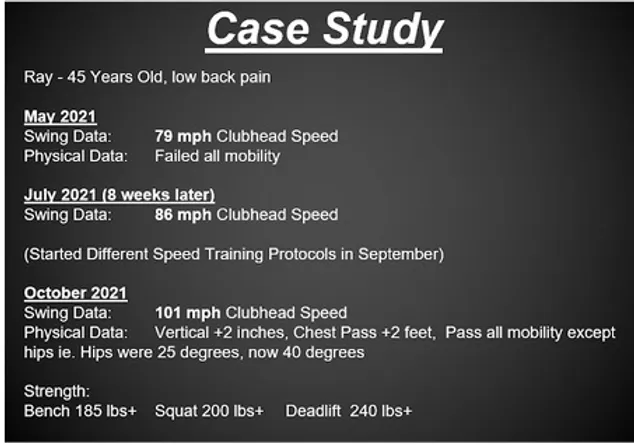
Ground Reaction Forces – What Are They And Why Are They Important?
What are they? Well, it’s simply stated that the laws of motion dictate that for every action there is an equal and opposite reaction. For example: I push the ground with my feet to jump, the ground pushed back up on me equally to create the vertical movement.
There are 3 ground reaction forces that we deal with: vertical (up/down), horizontal (side to side or lateral) and rotational (heel to toe or torsional) forces.
These 3 forces are often quite confusing for the everyday golfer – so who cares? Why bother with them? Can’t I swing without using these forces?
Well, you could – but imagine swinging at a golf ball on ICE with frictionless shoe-wear. Good luck. I would fall and so would you! Even if you were to swing from your knees – you are still using ground reaction forces – just through your knees and not through your feet. These forces are very pivotal to understanding the golf swing and how to swing efficiently and “effortlessly” – with speed!
Check out this quick 5 minute video about ground reaction forces that I published about a month ago to learn more!
Gaining the correct “kinetic” sequence (meaning the ground reaction forces being in the correct order) will transform your swing and lead to gaining 10+ mph for a lot of golfers. This is an area that can take time to develop – so coaching through this process is very important. If you’re wanting coaching in this area, schedule a free 30 minute golf evaluation and let’s go over this together. Reprogramming movement patterns for the golf swing from the ground up can take TIME, and each person is very unique with how they move, so there is not a one size fits all approach to accomplishing this.
So What? How Do I Actually Do This For My Game?
A cookie cutter program won’t accomplish the results that you’re likely wanting to achieve. A majority of us need coaching to become a better golfer when it comes to our golf swing – the same is true for golf performance or golf fitness. There are many things out there that are very generic and cookie cutter… You could do yoga – you could do some golf fitness App or program that you find online or on YouTube or Instagram – and these things may actually help you and be beneficial, but is it OPTIMAL for what you need? Maybe not. If you want to get better and you actually have goals in mind of achieving:
“I want to be hitting the ball 20 yards further” ; “I want to play golf injury free for a year and be able to play almost every day without feeling restricted or limited and not feel tight”
Then you need something that is tailored to YOU. None of this generic stuff is going to really help you in the long run if it doesn’t take into account what you actually need for your body. And this requires coaching. This requires accountability and a process that holds you accountable to achieving the results you’re looking for for your golf game.
So how do you add speed to your game? Coaching is paramount to your success to keep you injury free and to develop a program that is right for you to gain effortless speed for your game.


